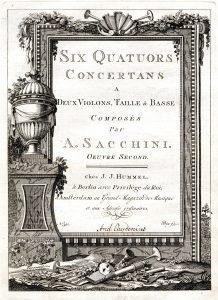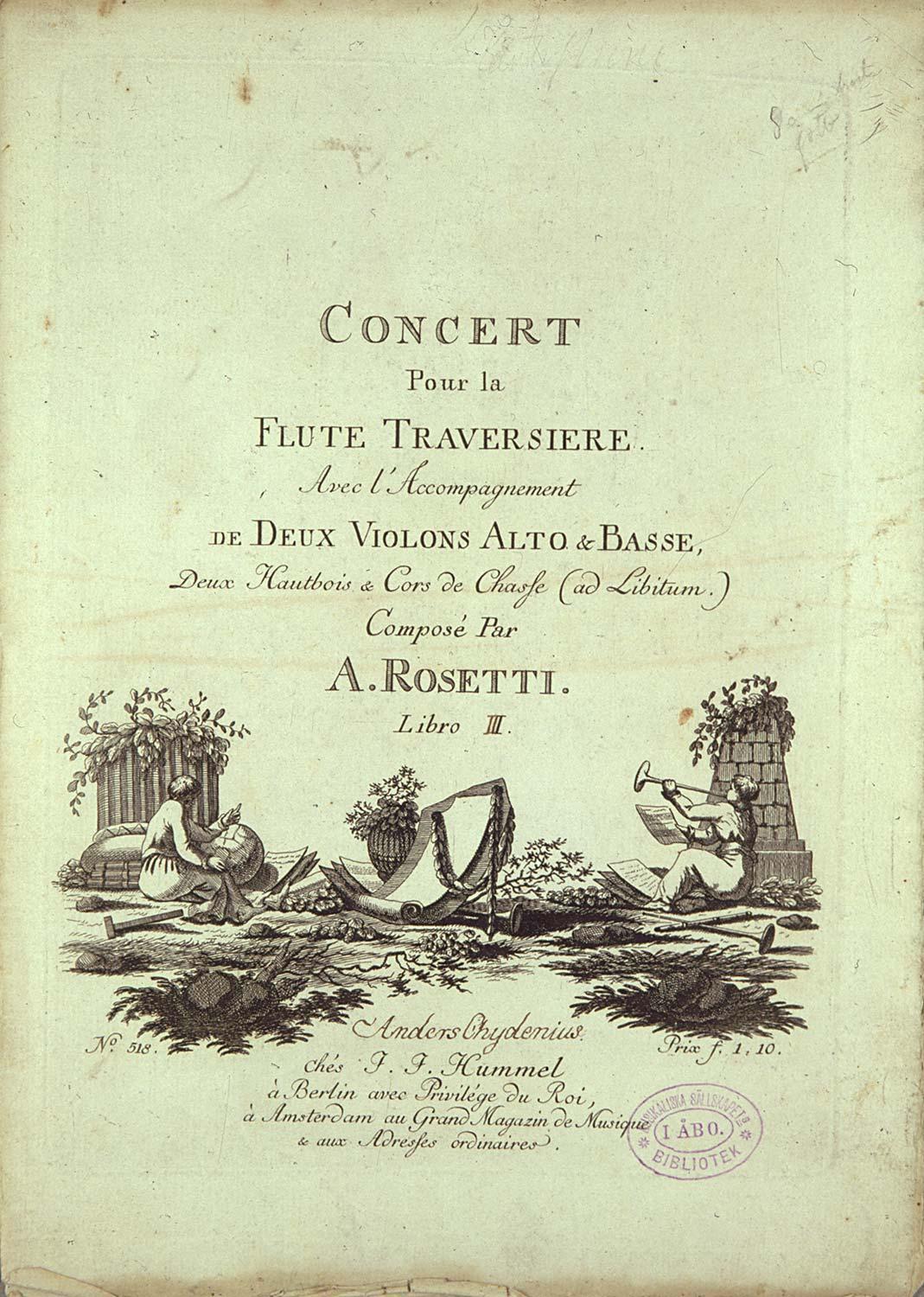The Anders Chydenius Collection and its composers
ANDERS CHYDENIUS was collecting music at a time when public concerts and interest in classical music were just taking their first steps in Finland. His collection occupies an important position in Finnish musical history. Similar, much bigger private collections had long before been made in Central Europe and Sweden, but the musical vision in the spirit of the Enlightenment of the vicar of a small, remote parish was quite exceptional.
There is only one vocal work in Chydenius’s collection, but it is all the more well-known: the Stabat Mater of 1736 by Giovanni Battista Pergolesi. In the manuscript headed Motetto, the Catholic mysticism has been replaced in the vocal text (translated into Swedish) by Lutheran tenets. The work had been regularly performed as such in Stockholm as early as the late 1740s. The rest of the collection consists of instrumental music of the 1760s–1780s. Though not all the composers are nowadays familiar, many of them were renowned and influential in their day. In this sense, the little town of Kokkola was for a moment apace with the European centres of music.
The collection of the Musical Society of Turku now in the Sibelius Museum contains 11 music books, with over 50 individual works in all, bearing Anders Chydenius’s initials. Whether this is actually all he owned is not certain; some may have got lost or mixed up with the Society’s other collections.
Nor is it certain when Chydenius acquired them. From a practical perspective, he probably bought them according to the degree of enthusiasm and the number of able musicians available. The oldest pieces were first mentioned in the publications catalogue of J.J. Hummel in 1764. Three of the items in the collection were published in that decade, three date from the 1770s, and two from 1781. Naturally, the year of publication indicates only the earliest possible acquisition date, because all the works published by Hummel remained in the catalogues for decades. Assuming that Chydenius kept an eye on the Hummel catalogues and maybe musical life in Stockholm for some years, his first acquisitions could have included the manuscript copy of Pergolesi’s Stabat Mater, a manuscript copy of the keyboard quartets by Lebrecht Julius Schulz, and printed copies of the symphonies by Franz Xavier Richter and quartets by Gaetano Pugnani. Most of the chamber music was probably purchased during the most active period around the mid-1770s, with the further addition in the early 1780s of the Rosetti flute concerto and Graf string quartets.
Gaetano Pugnani (1731–1798) was a major figure in the Italian violin school. After studying with Giovanni Battista Somis, a pupil of the father of violin playing Arcangelo Corelli, he in turn passed the tradition on to his own pupil, Giovanni Battista Viotti, founder of the French violin school. Pugnani is thus the musical forefather of most of today’s violinists. He was particularly famous for his singing string technique; the “archetto alla Pugnani” was longer and straighter than the typical Baroque bow and influenced the modern bow type of Tourte.
Though Pugnani spent most of his life in Turin, he was also an international virtuoso whose fame took him to such cities as Paris, London, Vienna and St. Petersburg. He lived in London for a couple of years in the latter half of the 1760s and there appeared in a concert series organised by Carl Friedrich Abel and Johann Christian Bach. The collection of six clavier quartets of 1774 by Abel would in time end up in the collection of Anders Chydenius.
Pugnani composed orchestral and chamber music and works for the stage. The quartets on this disc first appeared in Paris in the 1760s, in a collection titled Pièces à plusieurs parties. Hummel’s catalogue first mentioned Trè Quartetti à Due Violini Alto Viola & Basso Continuo, Composti da G: Pugnani in 1764. Pugnani’s music was well known in Sweden (to which Finland belonged) at the end of the 18th century. Printed editions of many works of that time, along with manuscript copies, have been preserved in Swedish libraries. No fewer than three manuscript copies and one printed edition exist of the quartets on this disc.
These works by Pugnani are sometimes quoted as examples of early string quartets. The printed edition nevertheless hints at the option of an orchestral performance. At a couple of points a separate part for double bass is marked in the basso continuo of the first quartet (played by the Ostrobothnian Chamber Orchestra on the Alba disc ABCD 186); the other two give a few performance instructions, which would again seem to point to an orchestral version. The basso continuo is equipped with a figured bass, which suggests the presence of a harmony instrument. This was, however, common practice at the time and maybe intended to allow the music more widespread use. The figured bass may be regarded as a historical relic; on the other hand, it shows that the instruments in a quartet were not necessarily yet fully fixed. The fact that the music is not very chamber-like and is in many places more in the contemporary Italian orchestral style also speaks on behalf of an orchestral performance. The singing style of Pugnani, also greatly admired as the leader of his own orchestra, is particularly marked in the first movements of these works. The virtuosic, emotionally-charged and dance-like twists in the music also add extra nuances.
Christian Ernst Graf (1723–1804) was a German-Dutch musician who began his career in the court Kapelle of Rudolfstadt, his home town in Thuringia. In around 1750, he departed for the Netherlands without his patron’s permission and after working in several places settled in The Hague as Kapellmeister to Prince William of Orange. It was here that he experienced one of the highlights of his career, at least from today’s perspective. For visiting the town in 1765 was nine-year-old Wolfgang Amadeus Mozart who, with his sister Nannerl, performed at a concert Graf was conducting. A year later, Mozart published his piano variations KV 24 based on a theme composed by Graf.
The collection of Graf string quartets is the latest of the items in Chydenius’s library, the Six Quatuors à Deux Violons, Taille et Basse – – – composés par C.E. Graaf. These were probably published in 1781, for the Berlinische Nachrichten von Staats- und gelehrten Sachen for September 8 carried an announcement to this effect. The collection is first mentioned in the Hummel catalogue – according to which Chydenius probably decided what to buy – in 1783. Written across the cover of the viola part owned by Chydenius is “1785”; maybe that was when it was purchased or played. Chydenius did also own some earlier works by Graf: the collection of flute/string quartets published in 1773. Maybe the vicar liked them so much that he decided to buy more by the same composer.
The string quartet on this disc is in three movements. In the first, the different instruments occupy a fairly equal role in the thematic development. The second movement is a solo for the first violin over a pulsating, rhythmic accompaniment, and the quartet ends with a jolly Presto.
In 1776, Edition Hummel published a volume entitled Six Quatuors à Violino ô Flauto Primo, Violino secondo, Alto & Violoncello. Composées Par M:r Campini. Opera Prima. The history of music knows of no composer called Campini, and the quartets are in fact by Giuseppe Maria Gioacchino Cambini (1746–1825). They were originally published as Op. 2 by Sieber of Paris in 1774. The name in the Hummel edition may be a misprint, or else it was an attempt to avoid a conflict of interest between the publishing companies.
Cambini was one of the most prolific 18th-century composers of instrumental music. Virtually nothing is known for certain about his life up to his arrival in Paris in the 1770s. The closing stages of his life are likewise shrouded in obscurity.
In Paris, Cambini was especially highly acclaimed as a composer of chamber music and works of the Sinfonia concertante type popular in France. He appears to have continued his successful career even after the French Revolution in 1789; by 1800, more than 600 compositions had been published in Paris in his name. Not all of them were necessarily his; at least some by Joseph Martin Kraus from Stockholm are known to have been published under the better-known name of Cambini.
In 1804, the Leipzig Allgemeine Musikalische Zeitung carried a recollection signed by Cambini of a string quartet active in Florence in the 1760s the members of which were the celebrated Pietro Nardini and Filippo Manfredi on violin and Cambini himself on viola. The cellist was Luigi Boccherini, the well-known virtuoso and composer (some of whose music was also in Chydenius’s collection). Although a similar item also featured in Cambini’s violin school as early as 1800, the story of “the first string quartet in the history of music” may with good reason be doubted, at least in view of certain anachronistic details. The cello part in the Cambini quartets in Chydenius’s library contains sections of concertante type that prove that Cambini was in any case familiar with the new performance technique represented by Boccherini. The cellist at Chydenius’s vicarage may have been Anders Röring, lecturer in chemistry at the Turku Academy, while visiting his native Kokkola region. When he gave a recital with violinist Erik Tulindberg and violinist Isak Nordberg, lecturer in mathematics at the Turku Academy, in 1782, Henrik Gabriel Porthan described the performers as veritable virtuosi.
“The music – – – was full of that clearness, grace and elegant simplicity which characterise the productions of that author,” wrote Charles Burney in speaking of the opera La Contadina in Corte by Antonio Sacchini (1730–1786) in The Present State of Music in Germany, The Netherlands and United Provinces (1773) after hearing it at a certain German court. Sacchini was in his day the best known of the composers on this disc and the most highly-acclaimed internationally. His popularity was also reflected in the concert life of Stockholm: whereas the city’s concert calendar for the late 18th century bears only a few references to the other composers on this disc, the name Sacchini occurs some 15 times.
Sacchini was born in Florence but received his musical education at one of the leading contemporary centres of the new style, Naples. While still a student, he was already making a name for himself as a gifted musician who, in addition to studying harmony and counterpoint, became an accomplished violinist and singing teacher. He began his career as a teacher at the Naples Conservatory but continued in Rome and Venice and soon elsewhere in Europe, especially as an opera composer.
In 1772, Sacchini moved to London and at the beginning of the following decade to Paris. Most of his chamber music dates from his years in London. The string quartet on this disc is from a collection of six quartets published by Hummel in 1778. In two movements, it begins with a brilliant Allegro of an operatic nature. The second movement is an elegant Minuet in keeping with the galant fashion of the times.
Most of what is known about the life of Lebrecht Julius Schulz (1732–1804) is stated on the cover of his only published collection of compositions: Six Quatuor a Cembalo obligato, Flute, Violon, & Basse ad libitum – – – composes par L.J. Schulz, Maitre de Musique de S.A.Sme Madame la Princesse Regnante de Solms Braunfels. In other words, he was teacher to the wife of the ruler of a small German principality, Braunfels. He was probably little known even in his day; whereas composers themselves in those days usually dedicated their collections to a noble patron, the dedication in Schulz’s was made by Johann Julius Hummel the publisher.
This collection of six quartets is clearly intended for amateurs. The interesting thing about this one is that the music in Chydenius’s library is a hand-written copy made by two people. The harpsichord part is in a different hand from the other parts. The source of the manuscript was the printed edition published by Hummel in around 1769. Who made the copies is anyone’s guess. Judging from the technical proficiency required and the clear content, the music could in any case have been suitable for performance by Chydenius’s music-loving ensemble in the early 1770s.
Lauri Pulakka
Lauri Pulakka has been first principal cello of the Ostrobothnian Chamber Orchestra for many years. He also holds a Doctorate in music, specialising in the performance practices of early music.
Translation: Susan Sinisalo
The article was published in the booklet of The Anders Chydenius Collection album (ALBA ABCD 449) in 2020.





